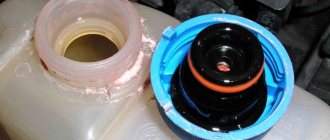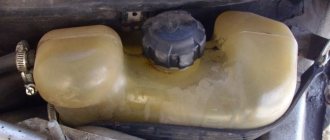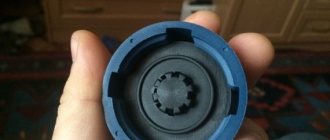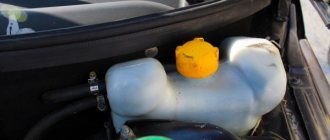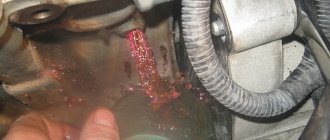Hi all! The topic of our conversation today will be the answer to the question of how to check the expansion tank cap with your own hands. Although some people do this with their mouth, I still do not recommend experimenting with your own health. There are much simpler and safer ways.
As you know, the expansion tank serves to store coolant. Just not to be confused with the anti-freeze tank, which is used as part of the windshield washer system. Without antifreeze or coolant (coolant), your internal combustion engine will not last long.
It is on this tank that there is a special lid. It would be more correct to call it a valve cover. The device seems simple, but in fact the lid bears a lot of responsibility.
Cover tasks
The serviceability of the valve cover from the expansion tank directly affects the performance of the entire cooling system of the power unit.
During operation, the engine heats up, which is quite natural and understandable to everyone. When the engine heats up, antifreeze takes away some of this heat so that the internal combustion engine does not overheat. When the coolant itself heats up, it increases in volume, that is, it expands, and at the same time the internal pressure in the system increases. The hotter the engine, the higher the pressure in the cooling system. In order to avoid ruptures of the pipes and the tank itself, the radiator and other components through which antifreeze or antifreeze passes, a valve cover is used.
It is very important not only to tighten the plug correctly, but also to periodically check its functionality. If repairs or replacements are required, they are carried out at the first sign of problems.
The lid serves not only as protection against overpressure. The design provides two valves, or one, but combining both functions. One valve serves to relieve excess pressure, and the other to inject it.
For the motor to work correctly, it must be maintained at operating temperature. Typically it is in the range from 95 to 120 degrees. Depends on the design features of the engine itself. At these temperatures, the expansion of the coolant occurs by approximately 20-30%. This leads to excess pressure. And normal pressure is considered to be 1.1-1.5 atmospheres. The valve cap of the expansion tank, if necessary, removes excess pressure from the system, or pumps it in so that a vacuum does not form inside, the pipes do not compress and the hoses do not stop circulating antifreeze.
If the plug is working correctly, the engine will operate at optimal temperature and normal operating pressure. If not, the consequences of a malfunction can be disastrous for the internal combustion engine. And the culprit is the usual lid.
How the lid works and how it works
This element has a simple structure:
- Plastic cover (shell);
- 2 springs with valve;
- Cork with holes;
- Rubber compressor.
The operating principle of the plug is also very simple: in the event of excessive heating of the cooling circuit, the regulator releases excess pressure. On the contrary, if it is low in the circuit, the regulator passes atmospheric air through itself to build up pressure. Thanks to the inlet valve, the cooling circuit is constant.
If one of the elements of the cooling circuit is leaking, air will enter the system. As a result, an air lock occurs. Where it leads? Overheating of the internal combustion engine or disruption of circulation in the entire system.
Cover device
It is important to understand that there is a locking element for expansion tanks on any car that has an internal combustion engine under the hood. And it doesn’t matter whether it’s diesel, gasoline or gas-powered.
Therefore, the problem with the failure of this unit can occur on any car, including such models as:
Checking the cover on VAZ 2108 – 2116 models
For each generation of cars, starting with the G8, the technology for examining the system tank plug is not very different. Let's figure it out in order.
Inspection of an element on a VAZ 2108/2109
The structure of the “eights” and “nines” allows you to check the readiness of the lid valves in just 60 seconds.
The procedure is as follows:
- Open the hood of the VAZ. Wait a couple of minutes for the internal combustion engine to stand for a while after use.
- Loosen the coolant reservoir cap.
- Squeeze the inlet pipe as hard as you can.
- At the same time as compressing the hose, tighten the plug on the neck.
- Then release the pipe.
It straightens out after compression, the valves are fine and you have nothing to fear.
Diagnostics of traffic jams on VAZ 2110—2112
The technology for checking this part is exactly the same as for all VAZ car models. The main difference is that when you open the lid, the mechanism installed in it may fall out.
Note: Symptoms of crankshaft sensor malfunction and checking it
This is not a sign of a malfunction, just a manufacturing defect. If it is not installed correctly, then this element of the circuit, alas, will not work for long.
Checking the part for the cooling circuit on the VAZ 2113—2116
It's simple, fellow motorists:
- Start the engine.
- Open the hood slightly and begin to unscrew the system reservoir cap.
- If, during the first manipulations, the sound of gases is heard from under the lid, everything is in order and there is nothing to worry about.
The developers of new models of the Russian brand are creating newer and more complex mechanisms. Therefore, checking the performance of valves in artisanal conditions may not bring results. In this case, you will have to contact service specialists. There you will be able to diagnose the cooling system reservoir cap using special equipment.
Which trailer suspension to choose?
- Lada Kalina;
- Ford Focus;
- Gazelle Next;
- Daewoo Lanos;
- Volkswagen Passat;
- Lada Priora;
- VAZ 2110;
- Renault Logan;
- Opel Astra;
- VAZ 2114;
- Chevrolet Lacetti, etc.
You already understand that the cap serves not only to prevent coolant from pouring out of the tank. This is also a pressure regulator in the system.
A valve is hidden inside the lid, usually made of plastic. It is he who takes on such responsibility. The valve is immersed inside the expansion tank and, as necessary, pumps or releases excess pressure.
Before buying a new element, if you suspect the old one is broken, you can check it. A similar type of locking mechanism should be selected.
Please note that all modern foreign cars, in the vast majority of cases, have switched to single-valve caps for expansion tanks. That is, only one valve design is physically present. It just can perform two functions at once. While on domestic cars you can still find a pair of valves. Each of them is responsible for performing a corresponding function. Whether this is good or bad is difficult to judge. But the fact remains a fact.
The lid is activated only when an excess or deficit of pressure is detected in the system. Each car has its own temperature and pressure standards for the element to operate.
Expansion tank cap design
The lock to the container should fit tightly, without gaps. For better connection, the lid is equipped with a rubber seal. By unscrewing it from the tank and looking at the inner surface, you can see a kind of pressure regulation sensor.
As mentioned above, there are two valves in the lid. One is designed to prevent engine overheating, the second prevents depressurization due to increased pressure.
Each of them received a name corresponding to its purpose. On VAZ cars, the high pressure valve is called a safety valve, and the low pressure valve is called a vacuum valve. Both devices are at rest until the pressure value approaches the limit value.
It is worth knowing that car owners may not always notice malfunctions in the operation of the cover valves. Visual inspection in most cases does not provide accurate information about the serviceability of devices. But a breakdown of one of the valves is fraught with serious consequences and can lead to expensive repairs.
Refrigerated trailer for a car: buy or make it yourself
- Thick white smoke is pouring out from under the hood;
- the engine overheats, but the stove remains cold;
- breaks the clamps;
- breaks the cooling system pipes;
- the radiator seal is broken;
- ruptures the coolant reservoir;
- the tubes are compressed and do not allow coolant to pass through;
- the circulation of antifreeze through the system is disrupted, etc.
Smoke usually appears when the pressure exceeds the permissible values. But overheating with a cold heater indicates precisely a lack of pressure in the system. Here it will be useful to remind you of the material devoted to eliminating an airlock. I'll leave a link to it. Go ahead and read.
Symptoms of a problem
If the internal combustion engine overheats, drivers try to find the problem under the hood, in particular, they check the cap of the cooling system reservoir, which maintains pressure in the cooling circuit. The unfortunate result of overheating can be antifreeze (antifreeze), which can get into the engine itself.
The main and main problem is the malfunction of the internal valve. If it malfunctions, air enters the system, resulting in an air lock. It does not allow antifreeze (antifreeze) to circulate properly inside the sealed cooling circuit.
If the cap or the inlet valve itself is faulty, the following may occur:
- Damage to the integrity of hoses due to exceeding their service life or poor quality materials;
- Melting of the thermostat shell;
- Leak formation in the radiator;
- Violation of the integrity of the tank containing the coolant.
Important! To prevent problems in the internal combustion engine that may arise:
- Replace a faulty part once every 2-3 years;
- Constantly monitor the level and quality of antifreeze that is poured into the system reservoir.
Why does antifreeze press out from under the coolant tank cap?
The main reason for the release of antifreeze from the expansion tank is a malfunction of the plug.
In addition to the locking element itself, there are a number of other reasons why coolant may escape:
- A crack in the body of the tank containing the antifreeze;
- Depressurization of the cooling circuit as a result of burnout of the engine head gasket;
- Poor pump performance. Because of it, circulation in the cooling circuit does not allow the insides to cool to an acceptable temperature;
- Thermostat failure;
- Cracks in the radiator;
- Cracks in hose and pipe connections.
Useful video
You can glean additional useful information from the video below:
The modern automobile industry dictates its own rules in the technical component, if previously some component was practically “invisible” (insignificant). Now, almost the performance of the entire power unit as a whole may depend on it. Ask - “what is this, an insignificant part?” YES at least the expansion tank cap. Moreover, on hot engines, it can be the cause of its “wedge”. And most importantly, it needs to be checked correctly! However, everything is in order (from simple to complex), and of course, the video version is at the end...
Now I won’t tell you in detail how the expansion tank plug works ; I already have a whole detailed article about it. In this material I will try to tell you how to check it correctly.
Repair of expansion tank cap
Radiator caps on modern cars are often made non-removable, so it is unlikely to be repaired. So you can remove traces of corrosion yourself and repaint the product or replace the rubber gaskets.
But if one or both valves fail, it will not be possible to disassemble them, since the body is in most cases cast. In cases where you can get to them, there is an option to try to clean them of dirt and replace the springs. Although this is a temporary measure and soon you will still have to go for a new cover.
Checking the expansion tank cap with a diagnostic device
Many who were interested in checking the cooling system plug have heard about a special diagnostic device. Such a tool is quite expensive; in 2022, I heard about an approximate amount of 15,000 rubles. Not every car owner can afford to buy such a tester. Therefore, it is only available to car services that constantly deal with such problems.
An ordinary car owner, if desired, can assemble a similar device on his own. To do this you will need the following components:
- radiator - can be taken from any old car, the condition does not matter, the main thing is that there is a whole upper part where the cover is attached;
- sandpaper;
- cold welding;
- camera nipple;
- compressor with precise pressure gauge.
The expansion tank is cut off from the radiator and all honeycombs are muffled so that air does not pass through the bottom. The same needs to be done with the side walls. Then a hole is made, the nipple from the camera is inserted into it and carefully sealed with cold welding. That's all, the device is ready.
Now you can move on to testing. The cover being tested is installed on the seat. The compressor is connected to the nipple, and air is pumped into the tank through it. By comparing the pressure gauge readings with the moment the excess pressure is released, one can judge the performance of the cover.
The main advantage of such a homemade product is the low cost of the device. The disadvantage is the complexity of manufacturing and lack of versatility. That is, the device will only fit if the diameter of the lid and the thread match. Otherwise, you will have to make another device, but from a suitable radiator.
The tester will help determine the operating pressure range of the expansion tank cap. Depending on the engine type, the readings may differ:
- Gasoline car. The safety valve opens at 83-110 kPa, for vacuum the opening pressure is -7 kPa.
- Diesel transport. For a safety valve, the value should be 108 kPa, ±15 kPa. The vacuum will open at 83 kPa.
The above values are averages, but you can use them as a guide. More accurate data on the pressure of the safety and vacuum valves can be found in the data sheet for your car, or on the manufacturers’ websites. If, during testing, the values obtained differ greatly from those indicated, then we can judge that this unit is faulty. Therefore, the cover needs to be replaced with a new one or try to be restored.
VAZ cars: repair, maintenance, tuning
Great things come from little things. So said some Chinese sage and, obviously, he was right. However, another wise Chinese said that you don’t need to think too much about great things, you need to not pay attention to the little things. And many car enthusiasts agree with the last one in absentia. For example, is such a trifle as the expansion tank cap worthy of our attention? It turns out that this plug is not so simple and not only the operation of the cooling system, but also the life of the entire engine depends on it.
I bought a new cover, but it doesn't work. What to do
Owners of VAZ 2110 and 2114 are sometimes faced with a situation where one or both valves on the purchased new expansion tank cap do not work. In this case, you can try to modify it. More often, valve malfunctions are associated with the manufacturer using too stiff springs.
To solve the problem, the first thing you need to do is disassemble the cover. This is done using a flat screwdriver and pliers. When disassembling, it is important to remember which part was placed where, as they can fly apart in different directions.
After removing the springs, they need to be trimmed a little - the large one (from the safety valve) is shortened by one turn, the small one (from the vacuum one) has two turns removed. When shortening the first part, it is important to take into account the moment the mechanism operates. The main thing here is not to overdo it and not to cut off too much. The second spring is a little easier - it should exert at least minimal pressure after closing.
Upon completion of the procedure, the components are assembled in reverse order. Now you need to check the functionality of the system and make sure that the valves operate at the right time.


